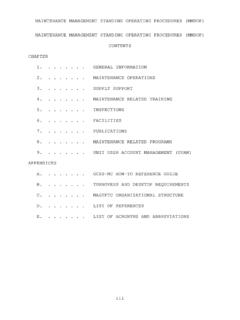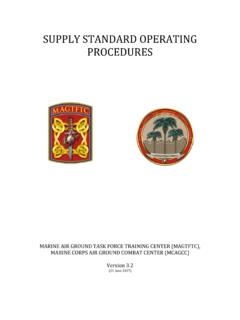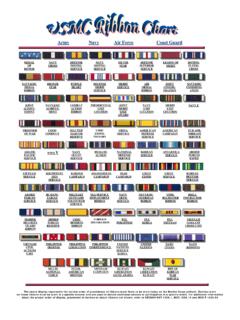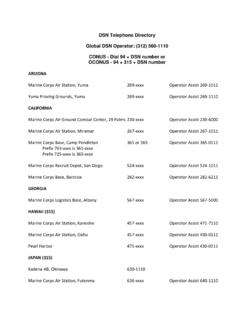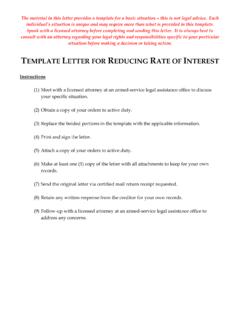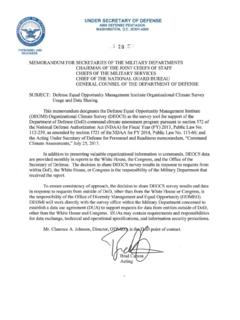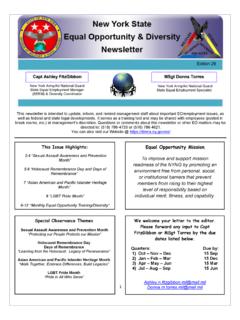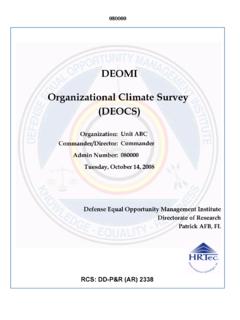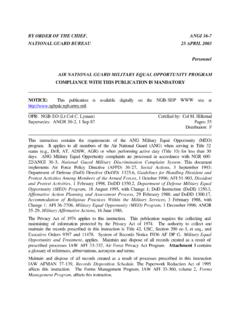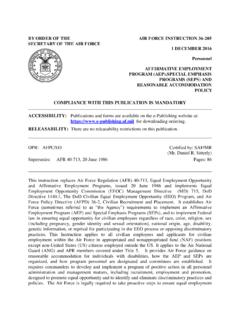Transcription of The Defense Equal Opportunity Management Institute …
1 The Defense Equal Opportunity Management Institute (DEOMI) Organizational Climate Survey (DEOCS) Directorate of Research 1 7/27/2004 General Description The DEOCS questionnaire is intended for organizations of any size and is suitable for military and/or civilian personnel. The questionnaire measures climate factors associated with the military Equal Opportunity (EO) program, civilian Equal employment Opportunity (EEO) program, and organizational effectiveness (OE) issues. DEOCS is administered in paper format. An Internet version is under development. The race-ethnic classification system used on DEOCS is consistent with recent Office of Management and Budget guidelines for classification of racial groups and multi-racial designations. The questionnaire contains 63 items, but military personnel will need to complete only 56 items. Approximately half the items address EO/EEO issues, the remainder address organizational and demographic areas.
2 The DEOCS is a climate assessment instrument, that is, it is designed to assess the shared perceptions of respondents about formal or informal policies, practices, and procedures likely to occur in the organization. It is not intended as a direct measure of EO/EEO attitudes. Through a statistical technique known as factor analysis, items that measure the same perceptual domain are combined into scales. In all, the DEOCS measures 14 climate factors: eight EO/EEO and six OE factors. These are all measured on a five-point scale. This summary of the questionnaire content is intended to acquaint the DEOCS user with the general content of the climate scales and demographic items. This will enhance interpretation of results and promote focused and accurate post-administration interpretation and action planning. Description of the 14 Climate Scales Scales 1-8 focus on perceptions of EO/EEO behaviors within the respondent's unit.
3 1. Sexual Harassment and (Sex) Discrimination. Perceptions of how extensively sexual harassment and discrimination (such as gender insensitive language, sexist jokes, or sexually suggestive language) are thought to occur within the respondent's unit. A typical item is, Sexist jokes were frequently heard. The factor is rated on the following scale, representing the respondent's estimation that sexually harassing or discriminating actions have taken place in the unit within the last 30 days: 1) There is a very high chance that the action occurred. 2) There is a reasonably high chance that the action occurred. 3) There is a moderate chance that the action occurred. 4) There is a small chance that the action occurred. 5) There is almost no chance that the action occurred. 2. Differential Command Behavior. Perceptions of differential treatment on the basis of race/ethnicity ( , A member was assigned less desirable office space because of their race/ethnicity.
4 The same scale is used as for factor 1. 3. Positive Equal Opportunity Behaviors. Estimates of how well majority and minority members get along in the unit and are integrated in the unit's functioning. The scale addresses The Defense Equal Opportunity Management Institute (DEOMI) Organizational Climate Survey (DEOCS) Directorate of Research 2 7/27/2004 how frequently positive actions occur and is the same as for factor 1. The scale is reverse scored, , responses are transformed so that, as with the other factor scores, higher is better. 4. Racist Behaviors. This factor taps perceptions of traditional overt racist behaviors, such as name calling and telling racist jokes. The same scale is used as for factor 1. 5. Age Discrimination. Perceptions of whether people are discriminated against because of their age. A sample item is, An older individual did not get the same career opportunities as did a younger individual.
5 The same scale is used as for factor 1. Administered to civilians only. 6. Religious Discrimination. Perceptions of whether people are discriminated against because of their religion. A sample item is, A supervisor favored a worker who had the same religious beliefs as the supervisor. The same scale is used as for factor 1. 7. Disability Discrimination. Perceptions of whether people are discriminated against because of their disability or handicap. A sample item is, A worker with a disability was not given the same opportunities as other workers. Administered to civilians only. 8. Overall EO Climate. This is a global measure of how the respondent views the Equal Opportunity climate within the unit of assignment. It reflects the respondent's rating on the following scale: 1) Very good 2) Good 3) About average.
6 4) Poor 5) Very poor Note that this scale is not derived from the other factors; rather, it gives a separate and independent assessment based on global perceptions of the climate. Factors 9-14 measure perceptions of organizational effectiveness (OE). They are measured on 5-point scales anchored by degree of agreement or degree of satisfaction. They are all scored so that higher scores represent more positive climate conditions. 9. Organizational Commitment. Measures bonding to the organization. A higher score means the respondent identifies with the organization to which he or she is assigned and would like to remain in that organization. Statements reflecting commitment are rated on the following scale: 1) Totally agree with the statement. 2) Moderately agree with the statement. 3) Neither agree nor disagree with the statement.
7 4) Moderately disagree with the statement. 5) Totally disagree with the statement. The Defense Equal Opportunity Management Institute (DEOMI) Organizational Climate Survey (DEOCS) Directorate of Research 3 7/27/2004 A sample statement is, "I feel very little loyalty to this organization." A rating of 5 would therefore mean a high degree of loyalty to the organization. 10. Trust in the Organization. An indicator of how people perceive the organization as a place where people trust and care for each other. A sample item is, This organization is loyal to its members. 11. Perceived Work Group Effectiveness. This factor reflects the degree to which the respondent's unit is perceived to be productive and effective in accomplishing its mission. It is measured in the same way as factor 9. A sample item is The quality of output of my work group is very high. 12. Work Group Cohesion. A measure of how work groups work well together, pull together on projects, and care for and trust each other.
8 A sample item is, My work group works well together as a team. 13. Leadership Cohesion. This measure is similar to Work Group Cohesion, but focused on how members perceive leaders above them working well together. A sample item is, Top leaders in my organization work together well as a team. 14. Job Satisfaction. Indicates the degree of satisfaction the respondent has with his or her current job. It is measured on the following reverse-scored scale: 1) Very satisfied. 2) Moderately satisfied. 3) Neither neither satisfied nor dissatisfied. 4) Moderately dissatisfied. 5) Very dissatisfied Demographic and Special Interest Items DEOCS contains 12 items that provide important information for post-administration analysis. Three items address perceptions of experiencing discrimination, reporting the incident, and satisfaction with the resolution Three items identify the gender and race-ethnic classification of the respondent One item measures the age category of the respondent Three items measure the personnel category of the respondent ( , officer, enlisted, or civilian status, military or civilian grade and classification) Two items identify the respondent s Branch of Service and type of organization Note: results are not reported for gender, rank, or race/ethnic groups if fewer than five respondents are represented in a particular subgroup.
9 For more information call the Directorate of Research at DEOMI: (321) 494-1586 DSN: 854-1586
